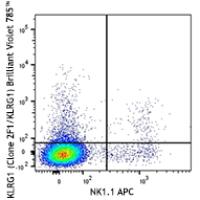-
Sign In
-

-
 Sony Biotechnology
Sony Biotechnology
-

-
 Sony Biotechnology
Sony Biotechnology
Brilliant Violet 785™ anti-mouse/human KLRG1 (MAFA)
Antibodies Single
Sony
2F1/KLRG1
Flow Cytometry
Hamster IgG
Human,Mouse
IL-2 activated NK cells from C57BL/6 mice
50 µg
1292145
$301.00
Description
Killer cell lectin-like receptor G1 (KLRG1) is the mouse homolog of the rat mast cell function-associated antigen (MAFA or 2F1-Ag). KLRG1 is a type II membrane glycoprotein that was first identified on the surface of rat mast cell line RBL-2H3. It is composed of a homodimer of glycosylated 30-38 kD subunits. Mouse and human homologs of KLRG1 are expressed by subsets of NK cells and lymphokine-activated killer (LAK) cells but not mast cells. KLRG1 is also expressed on subsets of CD8+ and CD4+ cells, including CD4+ and CD8+ effector/memory cells, potent regulatory CD4+ T cells. KLRG1 may be involved in regulating NK cell homeostasis. KLRG1 was found to recognize cadherins and thus inhibit immune responses by regulating the effector function and the developmental processes of NK and T cells.
Formulation
Phosphate-buffered solution, pH 7.2, containing 0.09% sodium azide and BSA (origin USA).Recommended Usage
Each lot of this antibody is quality control tested by immunofluorescent staining with flow cytometric analysis. For flow cytometric staining, the suggested use of this reagent is ≤0.5 microg per million cells in 100 microL volume. It is recommended that the reagent be titrated for optimal performance for each application.
Brilliant Violet 785™ excites at 405 nm and emits at 785 nm. The bandpass filter 780/60 nm is recommended for detection, although filter optimization may be required depending on other fluorophores used. Be sure to verify that your cytometer configuration and software setup are appropriate for detecting this channel. Refer to your instrument manual or manufacturer for support. Brilliant Violet 785™ is a trademark of Sirigen Group Ltd.
References
1. Robbins SH, et al. 2002. J. Immunol. 168:2585. (WB)
2. Robbins SH, et al. 2003. J. Immunol. 170:5876. (FC)
3. McMahon CW, et al. 2002. J. Immunol. 169:1444. (FC)


